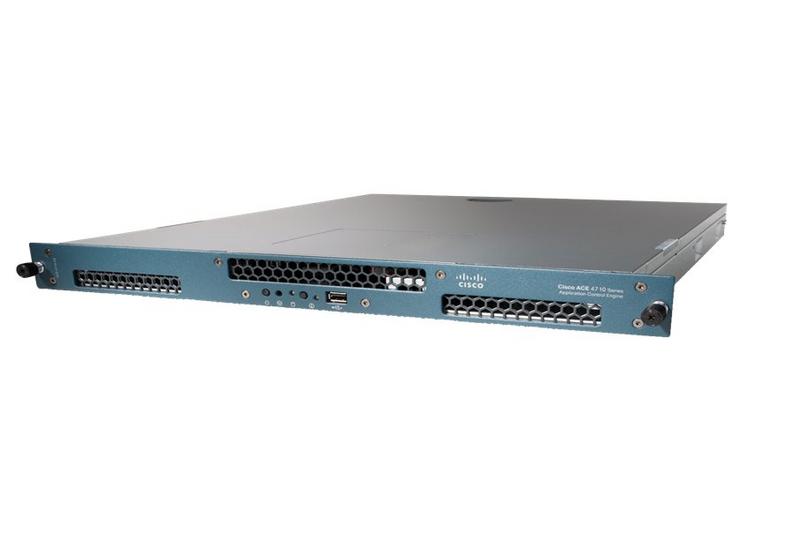Exclusive: Cisco Systems ACE 4710 review
Cisco claims the ACE 4710 has the most advanced application acceleration techniques on the market. Dave Mitchell evaluates.


The ACE 4710 impressed us mightily. It compares favourably on price with the competition, the optional application acceleration and optimization features are very sophisticated and the icing on the cake are the virtual appliance capabilities, which make this solution unique.

The 4710 adheres to the common concept for load balancing as it uses virtual servers to intercept web traffic. Multiple physical servers grouped together in farms are assigned to each virtual server and the appliance carries out load balancing across them. To define real servers you choose the context they should belong to and provide a name, IP address and a weighting. Load balancing choices include the standard weighted round robin and least connections but you can also opt for hashes based on a URL, address, cookie or header.
When creating virtual servers the Device Manager interface only displays those options that are relevant to your choices. Basic parameters include an IP address, protocol, application protocol and VLAN membership and for HTTPS the virtual server can act as a proxy server and terminate client SSL sessions itself.
Called stickiness, the appliance maintains persistent connections to farm members using source and destination addresses. Layer 7 inspection offers greater control as the appliance determines persistent connections based on actual content and uses functions such as HTTP headers, cookies and session IDs to ensure a host is always directed to the same physical server.
Cisco's optional application acceleration and optimisation adds significantly to the asking price but it does offer a range of very unusual features. FlashForward improves browser responses to users by reducing latency and works hand in hand with the user's local browser cache to reduce the traffic associated with object validation. FlashConnect fools browsers into thinking objects physically located on a single host are distributed across multiple hosts. This forces the browser to open more connections in parallel so increasing performance.
Delta optimisation responds to client requests by pulling web pages from the server farm and rewriting them in JavaScript before passing them on. When the client asks for the next page the appliance checks this with the current JavaScript and only passes on the changes, so resulting in fewer round trips. You also have just-in-time acceleration, which works with embedded objects that can't be cached.
Cisco's image optimisation is rather cool as the appliance rescans images as they are requested from the server and reduces detail in areas where it's unlikely to be noticed such as skies or seas. With all these tools to hand you'd think configuring them will be tricky but the Device Manager offers an 'EZ option' for virtual servers and selecting this simply switches all the key features on for you.
During testing we found the ACE 4710 very easy to work with as the Device Manager makes basic load balancing functions simple to configure. Feature-wise, there's not much than can touch this appliance - especially at this price point - making it a solid choice for data centres looking to improve their service responses but without significantly increasing their utility bill.
Sign up today and you will receive a free copy of our Future Focus 2025 report - the leading guidance on AI, cybersecurity and other IT challenges as per 700+ senior executives
Verdict
The ACE 4710 impressed us mightily. It compares favourably on price with the competition, the optional application acceleration and optimization features are very sophisticated and the icing on the cake are the virtual appliance capabilities, which make this solution unique.
Chassis: 1U rack Processor: 3.4GHz Intel Pentium 4 Memory: 6GB 667MHz DDR2 Storage: 1GB CompactFlash card Accelerator: Cavium Networks Octeon XL PCI-X card with 2GB memory Network: 4 x Gigabit Ethernet (Cavium) OS: Linux Other: CLI and web browser management
Dave is an IT consultant and freelance journalist specialising in hands-on reviews of computer networking products covering all market sectors from small businesses to enterprises. Founder of Binary Testing Ltd – the UK’s premier independent network testing laboratory - Dave has over 45 years of experience in the IT industry.
Dave has produced many thousands of in-depth business networking product reviews from his lab which have been reproduced globally. Writing for ITPro and its sister title, PC Pro, he covers all areas of business IT infrastructure, including servers, storage, network security, data protection, cloud, infrastructure and services.
-
 Gender diversity improvements could be the key to tackling the UK's AI skills shortage
Gender diversity improvements could be the key to tackling the UK's AI skills shortageNews Encouraging more women to pursue tech careers could plug huge gaps in the AI workforce
By Ross Kelly Published
-
 Researchers claim Salt Typhoon masterminds learned their trade at Cisco Network Academy
Researchers claim Salt Typhoon masterminds learned their trade at Cisco Network AcademyNews The Salt Typhoon hacker group has targeted telecoms operators and US National Guard networks in recent years
By Emma Woollacott Published
-
 HPE says unified channel strategy won't force Juniper partners to generalize
HPE says unified channel strategy won't force Juniper partners to generalizeNews Does the company embrace specialists or want a full portfolio push? The answer, it seems, is both
By Jane McCallion Published
